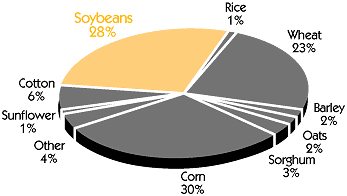The soybean (Glycine max) is often called the miracle crop. It is the world's foremost
provider of protein and oil. The bushy, green soybean plant is a legume related to clover,
peas and alfalfa. Farmers plant soybeans in the late spring. During the summer, soybeans
flower and produce 60-80 pods, each holding three pea-sized beans. In the early fall,
farmers harvest their crop for these beans which are high in protein and oil. A 60-pound
bushel of soybeans yields about 48 pounds of protein-rich meal and 11 pounds of oil.
More soybeans are grown in the United States
than anywhere else in the world. In 1998, U.S. soybean farmers harvested a record 2.757
billion bushels (75.04 million metric tons) of soybeans. More than half the total value of
the U.S. soybean crop is exported as whole soybeans, soybean meal and soybean oil.
As early as 5,000 years ago, farmers in China
grew soybeans.
In 1804, a Yankee clipper ship brought
soybeans to the U.S. When leaving China, sailors loaded the ship with soybeans as
inexpensive ballast. When they arrived in the U.S. they dumped the soybeans to make room
for cargo.
In 1829, U.S. farmers first grew soybeans.
They raised a variety for soy sauce. During the Civil War, soldiers used soybeans as
"coffee berries" to brew "coffee" when real coffee was scarce. In the
late 1800s significant numbers of farmers began to grow soybeans as forage for cattle.
In 1904, at the Tuskegee Institute in
Tuskegee, Alabama, George Washington Carver began studying the soybean. His discoveries
changed the way people thought about the soybean; no longer was it just a forage crop. Now
its beans provided valuable protein and oil.
By 1929, U.S. soybean production had grown to
9 million bushels. That year, soybean pioneer William J. "Bill" Morse left on a
two-year odyssey to China during which he gathered more than 10,000 soybean varieties for
U.S. researchers to study. Some of these varieties laid the foundation for the rapid
ascension of the U.S. as the world leader in soybean production.
Prior to World War II, the United States
imported 40 percent of its edible fats and oil. At the advent of the war, this oil supply
was cut. Processors turned to soybean oil.
By 1940, the U.S. soybean crop had grown to 78
million bushels harvested on 5 million acres, and the United States was a net exporter of
soybeans and soybean products. That year, Henry Ford took an ax to a car trunk made with
soybean plastic to demonstrate its durability. The publicity increased the soybean's
popularity.
In the early '50s soybean meal became
available as a low-cost, high protein feed ingredient, triggering an explosion in U.S.
livestock and poultry production.
U.S. Crop Area
Planted 2000 |

The U.S. soybean industry began
to look at ways to expand export markets. In 1956, the American Soybean Association (ASA)
began to promote U.S. soybeans in Japan.
Today, farmers in over 30 states grow
soybeans, making soybeans the United States' second largest crop in cash sales and the
number 1 value crop export. ASA now promotes soybeans and products in more than 100
countries with funding from the United Soybean Board and its soybean producer checkoff and
USDA's Foreign Agricultural Service.
U.S. soybean farmers invest a portion of their
income in promotion, education and research activities to help increase profits.
Farmer-funded research is in progress to cut production costs and to find new uses for
soybeans and soybean products. With this committed investment in the soybean, the miracle
crop faces an extremely bright future. |